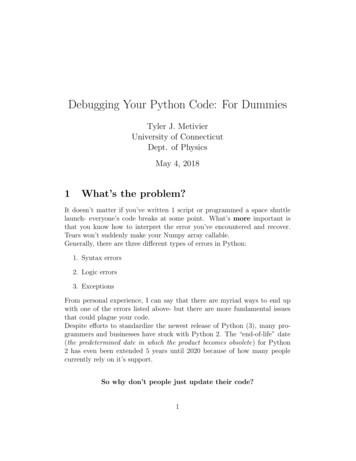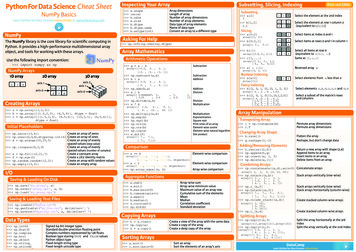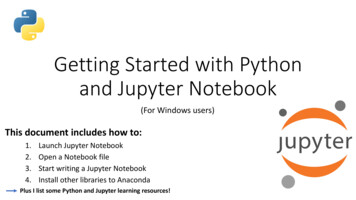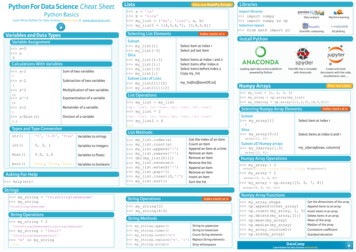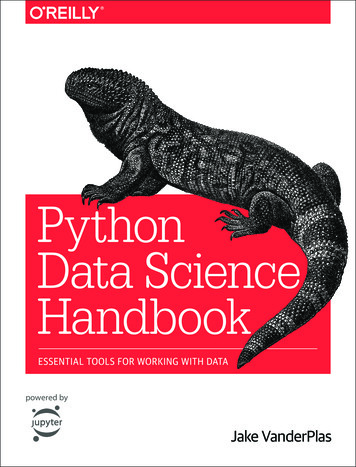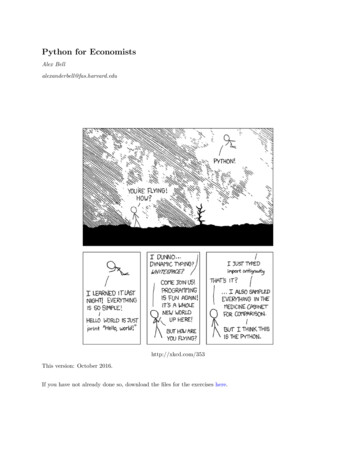
Transcription
Python Reference ManualRelease 2.1.1Guido van RossumFred L. Drake, Jr., editorJuly 20, 2001PythonLabsE-mail:python-docs@python.org
Copyright c 2001 Python Software Foundation. All rights reserved.Copyright c 2000 BeOpen.com. All rights reserved.Copyright c 1995-2000 Corporation for National Research Initiatives. All rights reserved.Copyright c 1991-1995 Stichting Mathematisch Centrum. All rights reserved.See the end of this document for complete license and permissions information.
AbstractPython is an interpreted, object-oriented, high-level programming language with dynamic semantics. Its high-levelbuilt in data structures, combined with dynamic typing and dynamic binding, make it very attractive for rapid application development, as well as for use as a scripting or glue language to connect existing components together. Python’ssimple, easy to learn syntax emphasizes readability and therefore reduces the cost of program maintenance. Pythonsupports modules and packages, which encourages program modularity and code reuse. The Python interpreter andthe extensive standard library are available in source or binary form without charge for all major platforms, and can befreely distributed.This reference manual describes the syntax and “core semantics” of the language. It is terse, but attempts to be exactand complete. The semantics of non-essential built-in object types and of the built-in functions and modules aredescribed in the Python Library Reference. For an informal introduction to the language, see the Python Tutorial. ForC or C programmers, two additional manuals exist: Extending and Embedding the Python Interpreter describes thehigh-level picture of how to write a Python extension module, and the Python/C API Reference Manual describes theinterfaces available to C/C programmers in detail.
CONTENTS1Introduction1.1 Notation . . . . . . . . . . . . . . . . . . . . . . . . . . . . . . . . . . . . . . . . . . . . . . . . .2Lexical analysis2.1 Line structure . . . . . .2.2 Other tokens . . . . . .2.3 Identifiers and keywords2.4 Literals . . . . . . . . .2.5 Operators . . . . . . . .2.6 Delimiters . . . . . . .11.335669103Data model3.1 Objects, values and types . . . . . . . . . . . . . . . . . . . . . . . . . . . . . . . . . . . . . . . . .3.2 The standard type hierarchy . . . . . . . . . . . . . . . . . . . . . . . . . . . . . . . . . . . . . . .3.3 Special method names . . . . . . . . . . . . . . . . . . . . . . . . . . . . . . . . . . . . . . . . . .111112174Execution model4.1 Code blocks, execution frames, and namespaces . . . . . . . . . . . . . . . . . . . . . . . . . . . .4.2 Exceptions . . . . . . . . . . . . . . . . . . . . . . . . . . . . . . . . . . . . . . . . . . . . . . . .2525265Expressions5.1 Arithmetic conversions . . .5.2 Atoms . . . . . . . . . . .5.3 Primaries . . . . . . . . . .5.4 The power operator . . . . .5.5 Unary arithmetic operations5.6 Binary arithmetic operations5.7 Shifting operations . . . . .5.8 Binary bit-wise operations .5.9 Comparisons . . . . . . . .5.10 Boolean operations . . . . .5.11 Expression lists . . . . . . .5.12 Summary . . . . . . . . . .29292932343535363636373839Simple statements6.1 Expression statements6.2 Assert statements . .6.3 Assignment statements6.4 The pass statement .6.5 The del statement .4141414244446. . . . . . . . . .i
6.66.76.86.96.106.116.126.13. . . .4545464646474848.49505050515253Top-level components8.1 Complete Python programs8.2 File input . . . . . . . . . .8.3 Interactive input . . . . . .8.4 Expression input . . . . . .5555555656A Future statements and nested scopesA.1 Future statements . . . . . . . . . . . . . . . . . . . . . . . . . . . . . . . . . . . . . . . . . . . .A.2future — Future statement definitions . . . . . . . . . . . . . . . . . . . . . . . . . . . . .A.3 Nested scopes . . . . . . . . . . . . . . . . . . . . . . . . . . . . . . . . . . . . . . . . . . . . . .57575859A History and LicenseA.1 History of the software . . . . . . . . . . . . . . . . . . . . . . . . . . . . . . . . . . . . . . . . . .A.2 Terms and conditions for accessing or otherwise using Python . . . . . . . . . . . . . . . . . . . . .616161Index6578iiThe print statement . .The return statement .The raise statement . .The break statement . .The continue statementThe import statement .The global statement .The exec statement . . .Compound statements7.1 The if statement . . .7.2 The while statement7.3 The for statement . .7.4 The try statement . .7.5 Function definitions .7.6 Class definitions . . .
CHAPTERONEIntroductionThis reference manual describes the Python programming language. It is not intended as a tutorial.While I am trying to be as precise as possible, I chose to use English rather than formal specifications for everythingexcept syntax and lexical analysis. This should make the document more understandable to the average reader, but willleave room for ambiguities. Consequently, if you were coming from Mars and tried to re-implement Python from thisdocument alone, you might have to guess things and in fact you would probably end up implementing quite a differentlanguage. On the other hand, if you are using Python and wonder what the precise rules about a particular area of thelanguage are, you should definitely be able to find them here. If you would like to see a more formal definition of thelanguage, maybe you could volunteer your time — or invent a cloning machine :-).It is dangerous to add too many implementation details to a language reference document — the implementation maychange, and other implementations of the same language may work differently. On the other hand, there is currentlyonly one Python implementation in widespread use (although a second one now exists!), and its particular quirks aresometimes worth being mentioned, especially where the implementation imposes additional limitations. Therefore,you’ll find short “implementation notes” sprinkled throughout the text.Every Python implementation comes with a number of built-in and standard modules. These are not documented here,but in the separate Python Library Reference document. A few built-in modules are mentioned when they interact in asignificant way with the language definition.1.1NotationThe descriptions of lexical analysis and syntax use a modified BNF grammar notation. This uses the following styleof definition:name:lc letter:lc letter (lc letter " ")*"a"."z"The first line says that a name is an lc letter followed by a sequence of zero or more lc letters and underscores. An lc letter in turn is any of the single characters ‘a’ through ‘z’. (This rule is actually adhered to forthe names defined in lexical and grammar rules in this document.)Each rule begins with a name (which is the name defined by the rule) and a colon. A vertical bar ( ) is used to separatealternatives; it is the least binding operator in this notation. A star (*) means zero or more repetitions of the precedingitem; likewise, a plus ( ) means one or more repetitions, and a phrase enclosed in square brackets ([ ]) means zeroor one occurrences (in other words, the enclosed phrase is optional). The * and operators bind as tightly as possible;parentheses are used for grouping. Literal strings are enclosed in quotes. White space is only meaningful to separatetokens. Rules are normally contained on a single line; rules with many alternatives may be formatted alternativelywith each line after the first beginning with a vertical bar.1
In lexical definitions (as the example above), two more conventions are used: Two literal characters separated by threedots mean a choice of any single character in the given (inclusive) range of ASCII characters. A phrase between angularbrackets ( . ) gives an informal description of the symbol defined; e.g., this could be used to describe the notionof ‘control character’ if needed.Even though the notation used is almost the same, there is a big difference between the meaning of lexical andsyntactic definitions: a lexical definition operates on the individual characters of the input source, while a syntaxdefinition operates on the stream of tokens generated by the lexical analysis. All uses of BNF in the next chapter(“Lexical Analysis”) are lexical definitions; uses in subsequent chapters are syntactic definitions.2Chapter 1. Introduction
CHAPTERTWOLexical analysisA Python program is read by a parser. Input to the parser is a stream of tokens, generated by the lexical analyzer. Thischapter describes how the lexical analyzer breaks a file into tokens.Python uses the 7-bit ASCII character set for program text and string literals. 8-bit characters may be used in stringliterals and comments but their interpretation is platform dependent; the proper way to insert 8-bit characters in stringliterals is by using octal or hexadecimal escape sequences.The run-time character set depends on the I/O devices connected to the program but is generally a superset of ASCII.Future compatibility note: It may be tempting to assume that the character set for 8-bit characters is ISO Latin-1(an ASCII superset that covers most western languages that use the Latin alphabet), but it is possible that in the futureUnicode text editors will become common. These generally use the UTF-8 encoding, which is also an ASCII superset,but with very different use for the characters with ordinals 128-255. While there is no consensus on this subject yet, itis unwise to assume either Latin-1 or UTF-8, even though the current implementation appears to favor Latin-1. Thisapplies both to the source character set and the run-time character set.2.1Line structureA Python program is divided into a number of logical lines.2.1.1 Logical linesThe end of a logical line is represented by the token NEWLINE. Statements cannot cross logical line boundariesexcept where NEWLINE is allowed by the syntax (e.g., between statements in compound statements). A logical lineis constructed from one or more physical lines by following the explicit or implicit line joining rules.2.1.2 Physical linesA physical line ends in whatever the current platform’s convention is for terminating lines. On U NIX, this is theASCII LF (linefeed) character. On DOS/Windows, it is the ASCII sequence CR LF (return followed by linefeed). OnMacintosh, it is the ASCII CR (return) character.2.1.3 CommentsA comment starts with a hash character (#) that is not part of a string literal, and ends at the end of the physical line. Acomment signifies the end of the logical line unless the implicit line joining rules are invoked. Comments are ignoredby the syntax; they are not tokens.3
2.1.4Explicit line joiningTwo or more physical lines may be joined into logical lines using backslash characters (\), as follows: when a physicalline ends in a backslash that is not part of a string literal or comment, it is joined with the following forming a singlelogical line, deleting the backslash and the following end-of-line character. For example:if 1900 year 2100 and 1 month 12 \and 1 day 31 and 0 hour 24 \and 0 minute 60 and 0 second 60:return 1# Looks like a valid dateA line ending in a backslash cannot carry a comment. A backslash does not continue a comment. A backslash doesnot continue a token except for string literals (i.e., tokens other than string literals cannot be split across physical linesusing a backslash). A backslash is illegal elsewhere on a line outside a string literal.2.1.5Implicit line joiningExpressions in parentheses, square brackets or curly braces can be split over more than one physical line without usingbackslashes. For example:month names ecember’]####These are theDutch namesfor the monthsof the yearImplicitly continued lines can carry comments. The indentation of the continuation lines is not important. Blankcontinuation lines are allowed. There is no NEWLINE token between implicit continuation lines. Implicitly continuedlines can also occur within triple-quoted strings (see below); in that case they cannot carry comments.2.1.6Blank linesA logical line that contains only spaces, tabs, formfeeds and possibly a comment, is ignored (i.e., no NEWLINEtoken is generated). During interactive input of statements, handling of a blank line may differ depending on theimplementation of the read-eval-print loop. In the standard implementation, an entirely blank logical line (i.e. onecontaining not even whitespace or a comment) terminates a multi-line statement.2.1.7IndentationLeading whitespace (spaces and tabs) at the beginning of a logical line is used to compute the indentation level of theline, which in turn is used to determine the grouping of statements.First, tabs are replaced (from left to right) by one to eight spaces such that the total number of characters up to andincluding the replacement is a multiple of eight (this is intended to be the same rule as used by U NIX). The totalnumber of spaces preceding the first non-blank character then determines the line’s indentation. Indentation cannot besplit over multiple physical lines using backslashes; the whitespace up to the first backslash determines the indentation.Cross-platform compatibility note: because of the nature of text editors on non-UNIX platforms, it is unwise to usea mixture of spaces and tabs for the indentation in a single source file.A formfeed character may be present at the start of the line; it will be ignored for the indentation calculations above.Formfeed characters occurring elsewhere in the leading whitespace have an undefined effect (for instance, they may4Chapter 2. Lexical analysis
reset the space count to zero).The indentation levels of consecutive lines are used to generate INDENT and DEDENT tokens, using a stack, asfollows.Before the first line of the file is read, a single zero is pushed on the stack; this will never be popped off again. Thenumbers pushed on the stack will always be strictly increasing from bottom to top. At the beginning of each logicalline, the line’s indentation level is compared to the top of the stack. If it is equal, nothing happens. If it is larger, it ispushed on the stack, and one INDENT token is generated. If it is smaller, it must be one of the numbers occurring onthe stack; all numbers on the stack that are larger are popped off, and for each number popped off a DEDENT token isgenerated. At the end of the file, a DEDENT token is generated for each number remaining on the stack that is largerthan zero.Here is an example of a correctly (though confusingly) indented piece of Python code:def perm(l):# Compute the list of all permutations of lif len(l) 1:return [l]r []for i in range(len(l)):s l[:i] l[i 1:]p perm(s)for x in p:r.append(l[i:i 1] x)return rThe following example shows various indentation errors:def perm(l):# error:for i in range(len(l)):# error:s l[:i] l[i 1:]p perm(l[:i] l[i 1:])# error:for x in p:r.append(l[i:i 1] x)return r# error:first line indentednot indentedunexpected indentinconsistent dedent(Actually, the first three errors are detected by the parser; only the last error is found by the lexical analyzer — theindentation of return r does not match a level popped off the stack.)2.1.8Whitespace between tokensExcept at the beginning of a logical line or in string literals, the whitespace characters space, tab and formfeed can beused interchangeably to separate tokens. Whitespace is needed between two tokens only if their concatenation couldotherwise be interpreted as a different token (e.g., ab is one token, but a b is two tokens).2.2Other tokensBesides NEWLINE, INDENT and DEDENT, the following categories of tokens exist: identifiers, keywords, literals,operators, and delimiters. Whitespace characters (other than line terminators, discussed earlier) are not tokens, butserve to delimit tokens. Where ambiguity exists, a token comprises the longest possible string that forms a legal token,when read from left to right.2.2. Other tokens5
2.3Identifiers and keywordsIdentifiers (also referred to as names) are described by the following lexical digit:(letter " ") (letter digit " ")*lowercase uppercase"a"."z""A"."Z""0"."9"Identifiers are unlimited in length. Case is significant.2.3.1KeywordsThe following identifiers are used as reserved words, or keywords of the language, and cannot be used as ordinaryidentifiers. They must be spelled exactly as written otorpassprintraisereturntrywhileReserved classes of identifiersCertain classes of identifiers (besides keywords) have special meanings. These are:Form***MeaningNot imported by ‘from module import *’System-defined nameClass-private name manglingNotes(1)(XXX need section references here.)Note:(1) The special identifier ‘ ’ is used in the interactive interpreter to store the result of the last evaluation; it is storedin the builtin module. When not in interactive mode, ‘ ’ has no special meaning and is not defined.2.4LiteralsLiterals are notations for constant values of some built-in types.2.4.1String literalsString literals are described by the following lexical definitions:6Chapter 2. Lexical analysis
scapeseq:shortstring longstring"’" shortstringitem* "’" ’"’ shortstringitem* ’"’"’’’" longstringitem* "’’’" ’"""’ longstringitem* ’"""’shortstringchar escapeseqlongstringchar escapeseq any ASCII character except "\" or newline or the quote any ASCII character except "\" "\" any ASCII character In plain English: String literals can be enclosed in matching single quotes (’) or double quotes ("). They can also beenclosed in matching groups of three single or double quotes (these are generally referred to as triple-quoted strings).The backslash (\) character is used to escape characters that otherwise have a special meaning, such as newline,backslash itself, or the quote character. String literals may optionally be prefixed with a letter ‘r’ or ‘R’; such stringsare called raw strings and use different rules for backslash escape sequences. A prefix of ’u’ or ’U’ makes the string aUnicode string. Unicode strings use the Unicode character set as defined by the Unicode Consortium and ISO 10646.Some additional escape sequences, described below, are available in Unicode strings.In triple-quoted strings, unescaped newlines and quotes are allowed (and are retained), except that three unescapedquotes in a row terminate the string. (A “quote” is the character used to open the string, i.e. either ’ or ".)Unless an ‘r’ or ‘R’ prefix is present, escape sequences in strings are interpreted according to rules similar to thoseused by Standard C. The recognized escape sequences are:Escape \Uxxxxxxxx\v\ooo\xhhMeaningIgnoredBackslash (\)Single quote (’)Double quote (")ASCII Bell (BEL)ASCII Backspace (BS)ASCII Formfeed (FF)ASCII Linefeed (LF)Character named name in the Unicode database (Unicode only)ASCII Carriage Return (CR)ASCII Horizontal Tab (TAB)Character with 16-bit hex value xxxx (Unicode only)Character with 32-bit hex value xxxxxxxx (Unicode only)ASCII Vertical Tab (VT)ASCII character with octal value oooASCII character with hex value hhAs in Standard C, up to three octal digits are accepted. However, exactly two hex digits are taken in hex escapes.Unlike Standard C, all unrecognized escape sequences are left in the string unchanged, i.e., the backslash is left in thestring. (This behavior is useful when debugging: if an escape sequence is mistyped, the resulting output is more easilyrecognized as broken.) It is also important to note that the escape sequences marked as “(Unicode only)” in the tableabove fall into the category of unrecognized escapes for non-Unicode string literals.When an ‘r’ or ‘R’ prefix is present, a character following a backslash is included in the string without change, and allbackslashes are left in the string. For example, the string literal r"\n" consists of two characters: a backslash anda lowercase ‘n’. String quotes can be escaped with a backslash, but the backslash remains in the string; for example,r"\"" is a valid string literal consisting of two characters: a backslash and a double quote; r"\" is not a value stringliteral (even a raw string cannot end in an odd number of backslashes). Specifically, a raw string cannot end in asingle backslash (since the backslash would escape the following quote character). Note also that a single backslashfollowed by a newline is interpreted as those two characters as part of the string, not as a line continuation.2.4. Literals7
2.4.2String literal concatenationMultiple adjacent string literals (delimited by whitespace), possibly using different quoting conventions, are allowed,and their meaning is the same as their concatenation. Thus, "hello" ’world’ is equivalent to "helloworld".This feature can be used to reduce the number of backslashes needed, to split long strings conveniently across longlines, or even to add comments to parts of strings, for example:re.compile("[A-Za-z ]""[A-Za-z0-9 ]*")# letter or underscore# letter, digit or underscoreNote that this feature is defined at the syntactical level, but implemented at compile time. The ‘ ’ operator must beused to concatenate string expressions at run time. Also note that literal concatenation can use different quoting stylesfor each component (even mixing raw strings and triple quoted strings).2.4.3Unicode literalsXXX explain more here.2.4.4Numeric literalsThere are four types of numeric literals: plain integers, long integers, floating point numbers, and imaginary numbers.There are no complex literals (complex numbers can be formed by adding a real number and an imaginary number).Note that numeric literals do not include a sign; a phrase like -1 is actually an expression composed of the unaryoperator ‘-’ and the literal 1.2.4.5Integer and long integer literalsInteger and long integer literals are described by the following lexical integer ("l" "L")decimalinteger octinteger hexintegernonzerodigit digit* "0""0" octdigit "0" ("x" "X") hexdigit "1"."9""0"."7"digit "a"."f" "A"."F"Although both lower case ‘l’ and upper case ‘L’ are allowed as suffix for long integers, it is strongly recommended toalways use ‘L’, since the letter ‘l’ looks too much like the digit ‘1’.Plain integer decimal literals must be at most 2147483647 (i.e., the largest positive integer, using 32-bit arithmetic).Plain octal and hexadecimal literals may be as large as 4294967295, but values larger than 2147483647 are convertedto a negative value by subtracting 4294967296. There is no limit for long integer literals apart from what can be storedin available memory.Some examples of plain and long integer literals:8Chapter 2. Lexical analysis
770377L0x800000000x100000000LFloating point literalsFloating point literals are described by the following lexical ntpart:fraction:exponent:pointfloat exponentfloat[intpart] fraction intpart "."(nonzerodigit digit* pointfloat) exponentnonzerodigit digit* "0""." digit ("e" "E") [" " "-"] digit Note that the integer part of a floating point number cannot look like an octal integer, though the exponent may looklike an octal literal but will always be interpreted using radix 10. For example, ‘1e010’ is legal, while ‘07.1’ isa syntax error. The allowed range of floating point literals is implementation-dependent. Some examples of floatingpoint literals:3.1410.0011e1003.14e-10Note that numeric literals do not include a sign; a phrase like -1 is actually an expression composed of the operator and the literal 1.2.4.7Imaginary literalsImaginary literals are described by the following lexical definitions:imagnumber:(floatnumber intpart) ("j" "J")An imaginary literal yields a complex number with a real part of 0.0. Complex numbers are represented as a pair offloating point numbers and have the same restrictions on their range. To create a complex number with a nonzero realpart, add a floating point number to it, e.g., (3 4j). Some examples of imaginary literals:3.14j2.510.j10j.001j1e100j3.14e-10j** /ˆ % ! OperatorsThe following tokens are operators: *& The comparison operators and ! are alternate spellings of the same operator. ! is the preferred spelling; isobsolescent.2.5. Operators9
2.6DelimitersThe following tokens serve as delimiters in the grammar:(, & ):- [.* ˆ ]‘/ { % };** The period can also occur in floating-point and imaginary literals. A sequence of three periods has a special meaningas an ellipsis in slices. The second half of the list, the augmented assignment operators, serve lexically as delimiters,but also perform an operation.The following printing ASCII characters have special meaning as part of other tokens or are otherwise significant tothe lexical analyzer:’"#\The following printing ASCII characters are not used in Python. Their occurrence outside string literals and commentsis an unconditional error:@10 ?Chapter 2. Lexical analysis
CHAPTERTHREEData model3.1Objects, values and typesObjects are Python’s abstraction for data. All data in a Python program is represented by objects or by relationsbetween objects. (In a sense, and in conformance to Von Neumann’s model of a “stored program computer,” code isalso represented by objects.)Every object has an identity, a type and a value. An object’s identity never changes once it has been created; youmay think of it as the object’s address in memory. The ‘is’ operator compares the identity of two objects; the id()function returns an integer representing its identity (currently implemented as its address). An object’s type is alsounchangeable. It determines the operations that an object supports (e.g., “does it have a length?”) and also definesthe possible values for objects of that type. The type() function returns an object’s type (which is an object itself).The value of some objects can change. Objects whose value can change are said to be mutable; objects whose value isunchangeable once they are created are called immutable. (The value of an immutable container object that contains areference to a mutable object can change when the latter’s value is changed; however the container is still consideredimmutable, because the collection of objects it contains cannot be changed. So, immutability is not strictly the sameas having an unchangeable value, it is more subtle.) An object’s mutability is determined by its type; for instance,numbers, strings and tuples are immutable, while dictionaries and lists are mutable.Objects are never explicitly destroyed; however, when they become unreachable they may be garbage-collected. Animplementation is allowed to postpone garbage collection or omit it altogether — it is a matter of implementationquality how garbage collection is implemented, as long as no objects are collected that are still reachable. (Implementation note: the current implementation uses a reference-counting scheme with (optional) delayed detection ofcyclicly linked garbage, which collects most objects as soon as they become unreachable, but is not guaranteed tocollect garbage containing circular references. See the Python Library Reference for information on controlling thecollection of cyclic garbage.)Note that the use of the implementation’s tracing or debugging facilities may keep objects alive that would normallybe collectable. Also note that catching an exception with a ‘try.except’ statement may keep objects alive.Some objects contain references to “external” resources such as open files or windows. It is understood that theseresources are freed when the object is garbage-collected, but since garbage collection is not guaranteed to happen,such objects also provide an explicit way to release the external resource, usually a close() method. Progr
described in the Python Library Reference. For an informal introduction to the language, see the Python Tutorial. For C or C programmers, two additional manuals exist: Extending and Embedding the Python Interpreter describes the high-level picture of how to write a Python extension m


